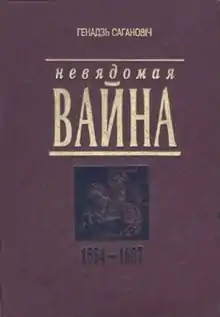 | |
| Author | Hienadz Sahanovich |
|---|---|
| Country | Belarus |
| Language | Belarusian |
| Genre | Military history, History |
| Publisher | Navuka i Tehnika |
Publication date | 1995 |
| Media type | Print (Hardcover) |
| ISBN | 5-343-01637-5 |
| OCLC | 36221525 |
The Unknown War is a military history book written by Hienadz Sahanovich. It describes the events of the war between Tsardom of Russia and the Polish–Lithuanian Commonwealth in 1654-67. The war has become known as a part of the "Deluge", a series of military conflicts that overwhelmed the Polish–Lithuanian Commonwealth in the middle of the 17th century which included the Khmelnytsky Uprising, the Swedish invasion, and the Russian invasion among others.
Importance
The book became one of the first in-depth researches of military actions during the Russo-Polish War (1654–67) which took place in the lands of the modern-day Belarus. The topic of armed conflicts between Russia and historical predecessors of the former Soviet Republics was largely forbidden in the times of the Soviet Union (this explains the book title). The book was released in 1995, four years after disintegration of the ex-USSR.
The Unknown War focuses on war events in the Grand Duchy of Lithuania, one of two integral parts of the Polish–Lithuanian Commonwealth (often generalized under the name of Poland). The dominant portion of lands that made up the Grand Duchy in the 17th century are today united in the Republic of Belarus, and hence, create a subject of historic analysis for Belarusian historians like Hienadz Sahanovich.
The book describes the following historical figures among others:
- Janusz Radziwill, Great Hetman of Lithuania
- Boguslaw Radziwill, Governor of the Duchy of Prussia
- Pawel Jan Sapieha, Great Hetman of Lithuania
- Tsar Alexis of Russia
- John II Casimir Vasa, King of the Polish–Lithuanian Commonwealth
- George II Rakoczi, Prince of Transylvania
- Magnus De la Gardie, Swedish governor of occupied territories
- Philip Abukhovich, Voivode of Smolensk
- Denis Murashka, commander of Belarusian (Lithuanian) guerrillas
- Wincenty Gosiewski, Field Hetman of Lithuania
- Ivan Khovansky, duke and voivode in the Russian army
- Alexei Trubeskoy, duke and voivode in the Russian army
Controversy
The book is sometimes criticized for putting excessive blame for casualties among the population of the Grand Duchy of Lithuania on hostilities committed by the Russian army (which operated in alliance with the Ukrainian Cossacks for the most time of the war). For example, the book says that population loss on the Belarusian lands exceeded 50% (for comparison, population loss during World War II in Belarus, one of the world worst hit territories, was about 25%).
However, these numbers do not differentiate between people who died as a result of military action, and victims of the Black Death which ran through Europe at about that time. Proponents of the book usually respond that the Black Death had a minimal effect of the Polish–Lithuanian Commonwealth in the 17th century.
Another argument against the data used in the book tables is that they often refer to the period between 1648 and 1667, and thus additionally account for population loss caused by the Khmelnytsky Uprising of 1648-1654 and not associated with the Russian invasion.
Example of a table from the book:[1]
4. Population Losses In The Belarusian Pavets in 1648-1667* Pavet (county) Number Of People Population Loss Prior the War After the War In Absolut Terms In Relative Terms Hrodna 174,398 115,323 59,075 33,9% Braslaw 39,291 16,978 22,313 56.8% Ashmyany 231,794 99,034 114,760 53.7% Lida 83,020 62,536 20,484 24.7% Vawkavysk 70,826 49,913 20,913 29.5% Slonim 77,154 62,523 14,631 18,9% Navahradak 288,743 166,133 122,610 42.5% Brest 283,185 146,841 136,344 48.1% Pinsk 162,834 92,371 70,463 43.3% Mensk 181,244 67,288 113,956 62.9% Mazyr 36,932 14,982 21,950 59.4% Rechytsa 30,394 11,804 18,590 61.2% Polatsk 162,478 40,930 121,498 74.8% Vitebsk 70,245 26,624 43,621 62.1% Orsha 473,200 145,015 328,185 69.3% Mstsislaw 96,383 27,540 68,843 71.4% * The table is based on the data provided by Vasil Mialeshka
Chapters
The book consists of the following chapters:
- Preface
- The Eve Of War
- Invasion
- Under The Rule Of "Liberators"
- The Last Campaign Of Radziwill
- "The Sovereign Foray" of 1655
- Around The Truce of Vilno
- Occupiers And Guerrillas
- Breakthrough
- Wasted Chances
- Andrusovo
- "To Oblivion And Forgetfulness"?
- Zusamenfassung
- Sources And Researches
- Addition
- Demographic Tables
- Biographies
The author
Hienadz Sahanovic (sometimes spelled as Gienadz Saganovich) is a Belarusian historian specialized in research of the Belarusian Middle Ages, history of the Grand Duchy of Lithuania. He is also known for his books Defending His Motherland. Kanstantin Astrozhski and Ten Centuries Of The Belarusian History (co-written with Uladzimir Arlow).